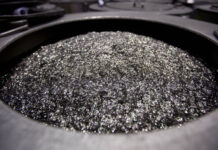
SIBANYE-Stillwater will move into net debt next year as capital expenditure from its battery minerals project pipeline ramped up, the miner said in a presentation on Tuesday.
Pressure on the group’s balance sheet would also be compounded by faltering platinum group metals (PGM) prices which comprise most of group revenue.
However, the financial strain of projects would eventually ease and result in an “ah-ha” moment when revenue from battery minerals outstripped PGMs.
“Where we are in the market currently, especially with PGMs, and as capital expenditure on the Keliber project ramps up, we will go slowly into a net debt position,” said Charl Keyter, CFO of Sibanye-Stillwater of 2024’s outlook.
Sibanye-Stillwater has committed to funding most of the €500m balance required to complete Keliber including its working capital and sustaining capital requirements. Equity funding of €250m had already been provided by the group.
Keliber, which is located in Finland, will produce 200,000 tons of lithium concentrate annually. First production, which will be from third party sources, is scheduled for 2025 with own production starting a year later. Lithium is a key mineral used in the manufacture of batteries for electric vehicles.
The miner also expects to make an investment decision next year on the Rhyolite Ridge lithium/boron project in the US. If approved, Sibanye-Stillwater will have to fund $490m of the project for a 50% stake (currently 7.1% shareholding).
Commenting on 2024, Keyter said net debt to adjusted Ebitda would remain “comfortably below” a ratio of 1x next year which is also well below Sibanye-Stillwater’s covenants with lenders of 2.5x net debt to adjusted Ebitda.
“We are busy with our 2024 operational plans and have an opportunity to reset and plan the operations so that we remain well below covenant levels,” said Keyter.
Funding of Rhyolite Ridge would be over four quarters and could involve external funding. “For Rhyolite Ridge, we will see our options at the time which also depends on cash flow.”
“There is a whole suite of options: term debt, or a bond,” said Keyter.
“We can see a case where some [of Rhyolite Ridge] – about 40% to 50% – can be funded with free cash flow,” he said.
‘Ah-ha’
Investors would see an “ah-ha” moment when revenue from battery minerals such as lithium would start to contribute to overall revenue, said Neal Froneman, CEO of Sibanye-Stillwater. Currently up to 85% of the group’s revenue is from PGM sales.
PGM prices have been hammered this year – the palladium price is down 43.5% this year – part of which is based on forecasts for a 30% absorption of battery electric vehicles (BEVs) which don’t require PGMs.
Froneman said this level of absorption was “driven by hype”. Electric power trains are “smart” and “modern” but availability of input minerals to make them was overstated, he said. “A portion of BEVs will not happen because they are too expensive … Something has got to give and penetration rates are highly overstated.”











